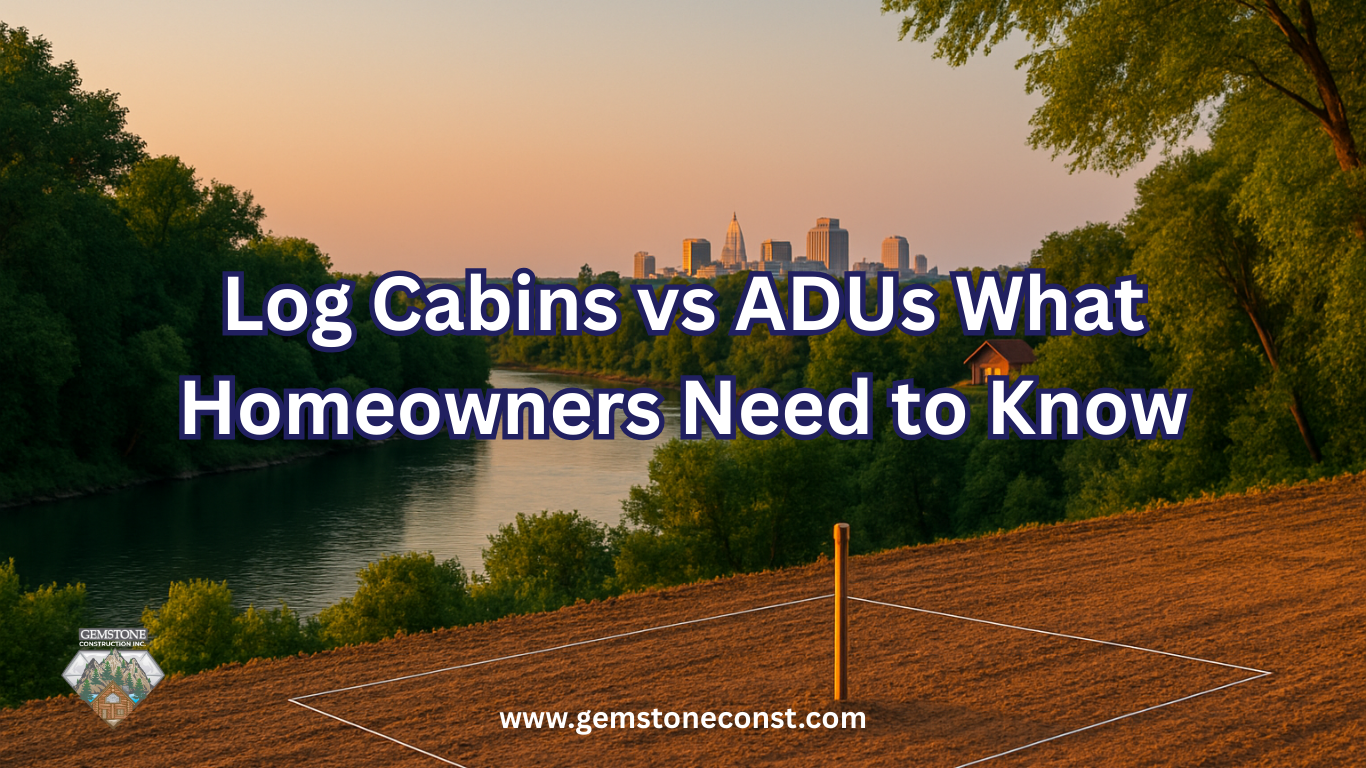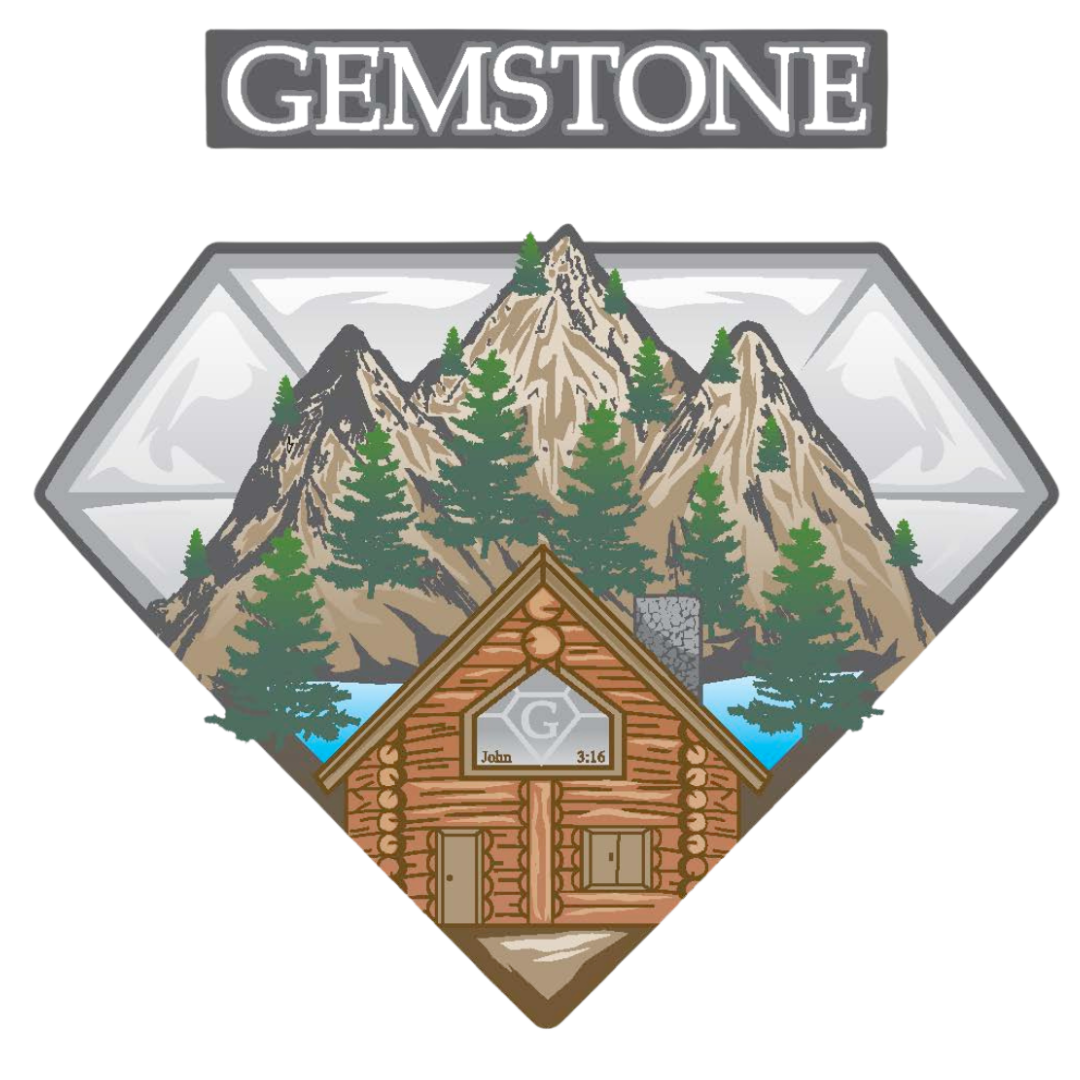GemStone Construction Blog
Log Cabins vs ADUs What Homeowners Need to Know
August 21, 2025 | Gemstone Construction | Sacramento, CA | USA

What counts as a log cabin and what counts as an ADU
A custom log cabin is a primary home on its own lot. It follows the full set of local zoning rules and the complete building code review the same as any other new house in the county. It stands alone, uses its own address, and becomes the main dwelling for the parcel. When families want space, privacy, and long term comfort, a full home often makes the most sense. That is the simple frame for the cabin side of this choice, and it is a helpful way to start the conversation in Sacramento.
An accessory dwelling unit is a self contained home on the same lot as an existing main house. It has its own kitchen, bathroom, and entrance, and it can be attached to the main home or detached in the yard. State law makes ADUs broadly allowed and defines them as complete, independent living spaces. The City of Sacramento and the County both provide clear steps to check if an ADU fits a property, and the state ADU page explains the basics in plain language. If you want a second small home for family or for rental income on the same lot, an ADU can be a very strong option, and the state resources confirm the definition and intent.
Everyday use and goals
People who choose a custom log home usually want a fresh start on land that matches their lifestyle. They picture a larger great room, a full kitchen, and a primary suite that faces morning sun. They may want space for a garden, a shop, or a wrap porch that catches Delta breezes. They also want a layout that fits how they live day to day, and they plan to stay for years. This path is about building a life in a stand alone home and letting every choice reflect that vision in a clear and personal way.
People who choose an ADU are often solving a different kind of problem. They want a place for a parent, a college age kid, or a renter, and they want it on the same lot as the main home. They care about privacy, yet they also care about proximity, since many use the ADU for family support. An ADU can also be a steady long term rental. Owners still care about comfort and energy use, and many of the same energy saving choices used in new cabins work perfectly in small units. The difference is scale, location on the lot, and how the new space fits beside the existing house rather than replacing it.
Financing and ownership basics
Cabins are financed like other custom homes when the land and plans are ready. Appraisers compare to similar new homes in the region, and the loan covers the full build and the permanent mortgage that follows. Because the cabin is the primary home, lenders and appraisers look at bedrooms, bathrooms, and square footage the same way they would for any house in the county. Owners can also shape utility choices to lower bills, which helps the long view feel both smart and comfortable in day to day life.
ADUs can be financed with cash out refinance, home equity, construction loans, or local programs when available. Appraisers often assign value to the ADU as added living area with income potential, and banks focus on the combined property. Some owners use rental income to offset costs, and the small footprint helps schedules. Ownership remains one parcel unless a city allows condo maps under newer laws, so plan to keep both dwellings together. This path is about adding flexible space to a lot you already love and making it work for your family and your budget.
Zoning and lot rules that guide the choice
Zoning is the map that decides what can be built and where it can sit on a lot. A new cabin must match the base zone for the parcel, so plan setbacks, height, and coverage the same way you would for any new home. The review team will also care about access for fire and the route for utilities. If your parcel touches a creek or sits close to a river bend, expect extra steps that protect banks and habitat. Those steps often start early and can shape where the home sits on the land in a way that feels smart and safe for many years.
State law makes ADUs widely allowed across California and sets strong rules that local agencies must follow. Many ADUs can sit as close as four feet from the side and rear property lines, and the state handbook explains this reduced setback allowance. Local handouts show how to measure that distance from the wall of the unit to the property line, and city pages explain special cases like when small units can sit in a front yard. In Sacramento, the published guides are clear, and they help owners spot the path that fits their lot so they can move fast and avoid dead ends. (ahcd.assembly.ca.gov)
Setbacks size and height at a glance
A cabin follows the standard yard setbacks in the zone, and those distances change by area. Corner lots can have larger side setbacks, and rural zones may allow more height for steep roofs and lofts. The goal is a safe and comfortable fit that respects neighbors and the street. When land sits near water or has a slope, the team may add geotechnical steps or ask for a specific pad height. Those steps are about safety, long life, and good drainage, and they make the home feel solid year after year.
An ADU follows a different playbook set by state law. The state rules protect certain minimum sizes and allow reduced side and rear setbacks, often four feet, so small homes can fit in typical backyards. Local handouts in Sacramento explain how to measure the setback and when fire rules can affect walls and openings that sit very close to a line. The city ADU guide also walks owners through a first check on whether an ADU is allowed on a parcel, which makes the first meeting smoother. A quick look at these sources before you sketch can save weeks and help you pick the right mass and shape for your lot.
Parking access and utility notes
Cabins need a full driveway, safe access for emergency vehicles, and standard space for parking. They follow the same water, power, and sewer rules as any other house. If the parcel lies near a creek or sits along the American River, staff may ask for proof that the design respects setbacks from the bank and avoids work in the stream zone. Those limits protect people, fish, and soil, and they help a home stand strong in storm seasons. Planning the location with those limits in mind leads to a smooth review and a layout that feels right on the land.
ADUs often come with relaxed parking rules, and many do not require a new parking stall in areas near transit or in neighborhoods with special conditions. The city and county pages explain when parking is required and when it is not. Access for construction still matters, so plan delivery routes and staging that respect fences, trees, and neighbor yards. Owners who scan these pages and bring a simple to scale plot plan to the first counter visit usually leave with clear next steps and a short list of items to prepare.
Permits and timelines what to expect
A new cabin follows full log home construction plan check. That means structural drawings, energy forms, site plans, and all the details needed for a ground up home. It takes longer than a small addition, but the result is a complete review that looks at the home as a system. When the parcel touches a stream or sits near a levee, other departments can join the review. The early site plan becomes the backbone for the whole process, and it keeps changes off the field and on paper where they cost less and move faster.
An ADU follows a streamlined track called ministerial review. That means staff check the plans against the rules and approve them when the design matches the code without a long public hearing. The state handbook spells out this intent, and the local pages in Sacramento mirror the process with step by step guides. Owners should still bring a clean packet and clear drawings because a complete submittal moves faster. The difference in the review path is one reason ADUs can be built quickly on many city lots.
What to bring to your first counter visit
Bring a parcel map with dimensions and a simple plot plan that shows the exact spot you want to build. Mark the distance to each property line and the distance between buildings. Include power, water, and sewer notes if you know them. Add two or three photos that show the lay of the land and any trees or fences that matter. These small steps show respect for staff time and help the reviewer give you a straight answer on the first day.
If your land sits near a creek or river bend, print the flood map page and mark the top of bank. Add the base flood elevation line if it applies to your parcel. If you are unsure about setbacks near water, make a note to ask where the county measures from on your property. Owners who walk in with this basic packet usually walk out with a punch list they can follow without confusion. That is how you keep time and money under control while you move toward permits with confidence.
Cost comfort and utilities
Cabins and ADUs share the same truth about comfort. A tight shell, smart windows, right size heating and cooling, and clean fresh air change the way a home feels and the way bills look. In Sacramento heat these moves add up every month, and they make rooms feel even and quiet. They also support indoor air quality on smoke days. Owners who plan comfort early enjoy a better daily life without chasing thermostats or fighting glare. Those same choices are easy to price, and they pay back with steady savings.
Costs land in different places for the two paths. Cabins carry full site work and full utility runs because the home is the main dwelling. ADUs share the parcel, and many share some existing service routes, which can trim dollars and time. Either way, long life choices for the shell and the mechanical system are smart money. If you want to dig into savings ideas in plain talk, scan the piece on energy smart upgrades and bring those notes to your design meeting. A small change in placement or glass can cut bills for decades in our valley climate.
Utility connections and service letters
Cabins benefit from early calls to the utility providers so capacity questions do not stall the schedule. A short email that asks about power, water, and sewer can bring quick guidance. If you plan to add solar and a battery, note that in the conversation, since it can affect panel size and meter location. A thoughtful early plan keeps trenches short, avoids root zones, and lines up meters where they are both safe and easy to read. Good drawings and a calm timeline make inspections smooth later.
ADUs can share water and power with the main home or use separate meters when allowed. The city pages explain how to prepare a plot plan with labeled lines, easements, and distances, and those details help a reviewer give a clear green light. Some owners add fresh air systems so the space stays comfortable when windows are closed during a smoke event in August. Others add simple shade trees on the west side to tame late day sun. These small touches make a small home feel like a big win for daily life. (building.saccounty.net)
How to choose for your life and your lot
Start with your real goals. Do you want a full time home that you can shape from the ground up, or a smaller second place beside your current house. Write down how many people will live there, how often you host, and how much storage you need for gear and hobbies. Then working with your Sacramento log home builder, sketch your lot to scale so you can see what actually fits after setbacks and access are marked. If you keep going back and forth on log cabin vs ADU California, list the top three must haves for comfort and the top three must haves for budget, and see which path matches both lists.
Now think like a Sac local. Walk the yard at breakfast, noon, and dinner to see sun, shade, and breeze patterns, because those small things become big comfort wins. Ask where cars will park and where a fire truck would turn, since those answers can steer building placement more than you expect. If the property sits near a creek or a drainage swale, check flood maps and note the top of bank before you pick a spot. Bring those notes to your first planning counter visit, and you will leave with clear next steps and a plan that feels right for your land.
Sacramento tips that keep projects moving
Call planning before you draw. A ten minute chat can save ten weeks of backtracking. Bring a parcel number and a simple map so the person on the phone can see what you see. Ask about setbacks, height, and any special notes for your block or your zone. Ask the building counter what they like to see in a first submittal packet. That small act of respect sets a better tone for the entire review.
Tell your closest neighbors what you plan to build. A short talk goes a long way when trucks show up for a few weeks. Keep work hours reasonable, sweep the street before the weekend, and protect trees and fences you do not own. These small courtesies reduce friction and clear the air. While you plan rooms and equipment, consider comfort steps that make a home feel even and quiet. Sacramento summers are bright and long. Shading and glass choices matter, and they pair well with shell and mechanical steps that cut bills for years.
FAQ Common questions owners ask
Are ADUs allowed on my property in the Sacramento area
State law allows ADUs broadly, and local pages in both the city and the county explain how to confirm your parcel is eligible. The city site has a step one page that asks a few simple questions about your zone and your lot. The county offers a clear handout that defines attached and detached units and explains when a minor permit may be needed for more than one story. Many owners find that a one story detached ADU fits in the rear yard of a standard city lot, and the state handbook supports this with plain rules that apply across California. Read the local guide to understand small local notes, then bring a sketch and a plot plan to your first counter visit.
An ADU must include a kitchen and a bathroom to count as an independent home. It can be attached to the main house or stand alone in the yard. It cannot be a short term rental in many places, and it must meet the building code the same as any other home. Neighborhood rules cannot erase the state right to build, but they can guide finishes and placement in some planned areas. The best path is to verify the basics on the state page, then work through the city or county steps with a clean packet and a friendly tone.
What are typical ADU setbacks and sizes in California
The state handbook explains that many ADUs can sit as close as four feet from side and rear property lines. This reduced distance helps small homes fit behind existing houses on city lots. It does not erase fire or building rules, and very tight placements can trigger wall and opening limits to protect life safety. The handbook also explains minimum size allowances the state protects, and it points to the parts of law that require cities to ministerially approve code compliant projects. These simple cornerstones make the ADU path predictable and faster than many other kinds of projects.
Local pages add useful details. The County handout explains how to measure setbacks from the wall of the unit to the property line. The City step one page shows a special case that allows a small ADU in a front yard when rear and side yards cannot fit one, and it explains where to look up your lot rules. Owners who read these two pages before they draw often find that small width changes or window moves make a plan sail through review. A short call with a local planner can confirm those details before you invest in final drawings.
Can I build a cabin or an ADU near a river or creek
Yes in many cases, but water brings extra steps. Counties protect stream corridors for safety and habitat, and some parcels include mapped flood zones. If your land sits near a creek or along the American River, ask where setbacks are measured and which departments review projects. Expect to bring a flood map page, a simple site sketch, and photos that show the top of bank. These documents help staff draw the line on your map and explain what is possible before you pay for final plans. Owners who start here avoid redesigns and save weeks on the schedule.
Access and utilities also matter near water. Driveway routes may need to cross a swale or a seasonal channel, and that can trigger special reviews. Early planning helps you place the home away from the lowest ground and plan quiet fresh air systems that keep rooms comfortable when windows are closed during smoke days. If you want a deeper dive on shoreline steps and buffers, scan our plain talk piece on riverside setbacks and stream planning and bring those notes to your first meeting. That early learning makes conversations with staff calm and productive.
What is the main decision point for log cabin vs ADU California
The first question is simple. Do you want a new primary home on its own lot, or do you want a second smaller home on the same lot as your current house. If you want to live in the new build full time and shape every room to your life, a cabin fits that dream. If you want a place for family or long term rental while you keep your main house, an ADU fits the bill. The next questions are about lot shape, setbacks, and access. These are local and physical, and they often answer the question on their own when you draw the plan to scale and measure the spaces in feet.
Comfort and bills also guide the choice. A cabin gives you a clean slate to include shell, glass, and equipment that tame Sacramento heat and winter fog. An ADU benefits from the same moves on a smaller scale and can share some utility routes, which helps budgets. If you enjoy planning efficiency early, take a look at the notes on energy smart upgrades and consider which of those steps fit your plan. The right mix lowers monthly costs and makes rooms feel even and quiet all year.
Can I rent an ADU as a short term rental in Sacramento
Many cities limit short term rentals in ADUs. The state ADU resources and local pages explain that ADUs are meant for long term housing and that local rules can restrict stays shorter than thirty days. Sacramento provides public guides that help owners understand what is allowed and what is not. Before you plan on nightly rentals, read the city page and call the planning desk to confirm current policy. Rules change, and the person at the counter will have the latest version, which keeps you out of trouble and your project on track.
If you plan to rent long term, design the space so it feels private and easy to maintain. Good light, quiet fresh air, and simple shade go a long way. Separate outdoor space helps, and a small patio near a planted screen can feel like a big perk to a tenant. These simple touches keep the unit appealing and cut turnover. They also help neighbors feel comfortable with the new use, which is good for the whole block.
Choose the right path for your land and your life
Both cabins and ADUs can be smart moves in the Sacramento area. The better choice depends on your goals, your lot, and your timeline. If you plan to build a main home, start with a clear site plan and a calm schedule. If you plan to add a small second home, read the city and county ADU pages and sketch the space within the setback box. In either case, you can weave in comfort steps that keep rooms even and quiet. Those steps pair naturally with the design phase and help the budget pay you back each month.
Ready to choose your path and get moving?
Contact
Gemstone Construction for a friendly plan review and a clear next step toward building your dreams in Northern California.
About Gemstone Construction
Gemstone Construction is a premier custom home and commercial building contractor serving Northern California, including the Sacramento area. Specializing in
custom log homes,
luxury home builds,
residential metal building construction, commercial construction and
commercial metal building construction. We bring craftsmanship, attention to detail, and personalized service to every project. From designing dream homes to building cutting-edge commercial spaces, our dedicated team ensures that each build reflects our clients' unique vision and exceeds expectations. Trust Gemstone Construction to transform your ideas into reality with integrity and excellence.
Learn more about Gemstone Construction

Contact Information


